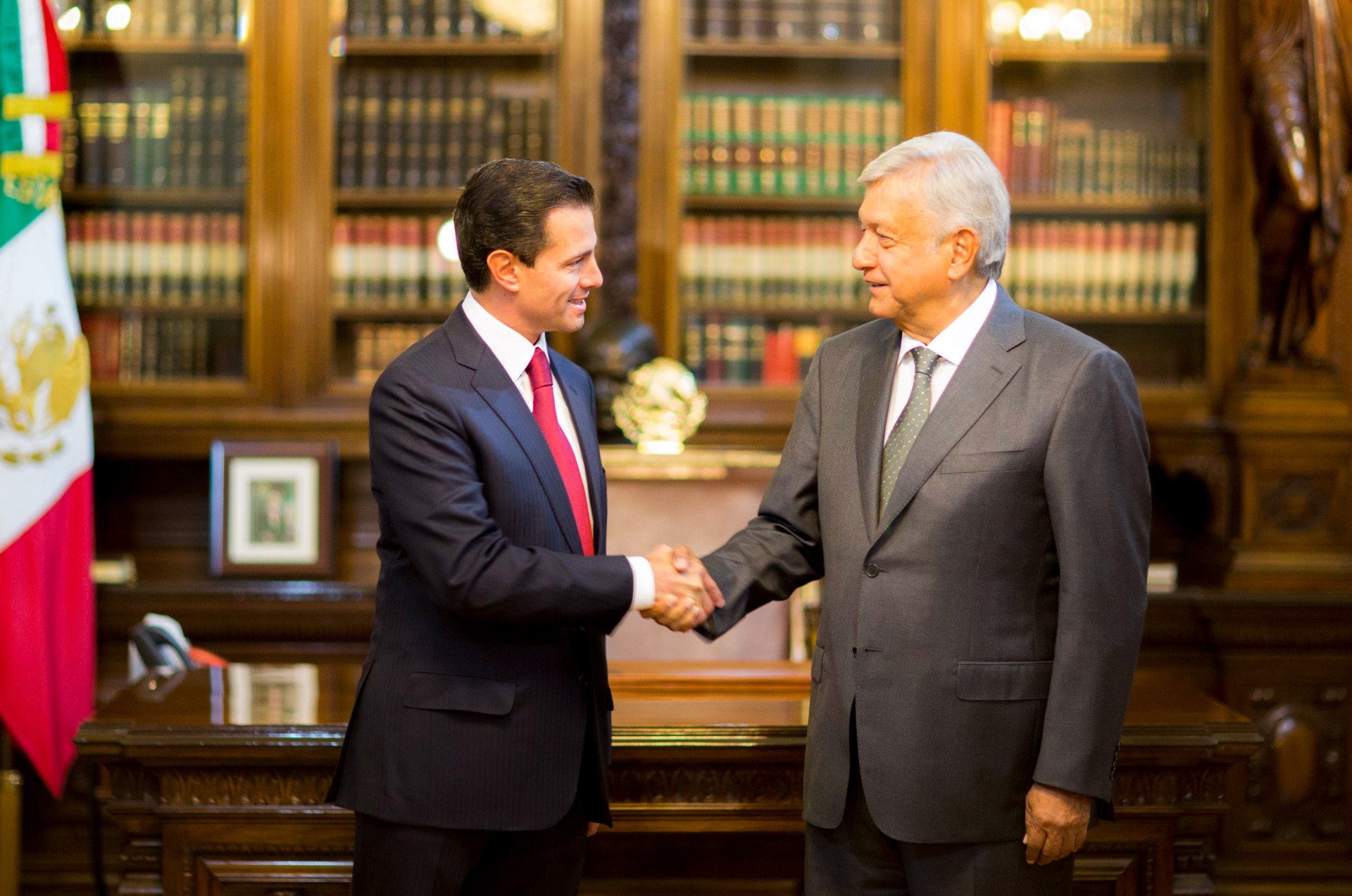By Jordi Díez, University of Guelph


Enrique Peña Nieto congratulates Andrés Manuel López Obrador (Photo by the Government of Mexico)
The election of a leftist party in Mexico for the first time in decades has the potential to transform the country as it dislodges its ruling elite, challenges the economic consensus and promises to eradicate violence and corruption.
In a country marked by extreme levels of violence and deep social polarization, the July 1 elections were remarkable.
With the second-highest voter turnout level in recent memory (63 percent), no allegations of fraud nor any reported incidents of violence, the leaders of the two parties (the right-of-center PAN and the pragmatic ruling PRI) that have dominated the country’s politics and economy for the last 40 years conceded defeat by 8:30 p.m. last Sunday to the leftist candidate, Andrés Manuel López Obrador (widely known as AMLO), even before official results were announced.
The prompt concessions attest to the magnitude of López Obrador’s landslide victory on his third attempt at reaching the presidency: Early returns gave the folksy southerner 53 percent of the vote, the highest for a presidential candidate in democratic Mexico, and projections on election night showed his coalition winning a congressional majority.
López Obrador was thus elected with ample political capital and the institutional levers required to transform the country.
The Gamble
Despite strong opposition from the country’s elite, for a plurality of Mexicans, López Obrador represented the best choice to tackle the country’s problems. Polling leading up to the election showed that he was considered by 43 percent of Mexicans to be the best candidate to reduce corruption; by 41 percent to improve the country’s economy; by 37 per cent to deal with public insecurity; and by 36 percent to combat drug cartels and organized crime. These were numbers twice as high as any of his rivals’.
Polling also showed, however, that, among his contenders, he was seen as the most likely to destabilize the country if elected.
The desire for change was such that Mexicans appear to have taken a gamble at the ballot box by voting for the riskier choice.
How Transformative a Change?
Yet, despite his portrayal as a leftist firebrand and the risk some see in his election, the more likely outcome is a gradual shift to a more redistributive economic model. Here are some highlights:
1) NAFTA
While a frequent critic of NAFTA, López Obrador is unlikely to seek major changes to the agreement, let alone try to annul it. During his victory speech, he repeated his idea that boosting economic growth, reducing poverty and preventing illegal migration to the United States required self-sufficiency in agricultural production.
Agricultural policy is therefore likely to be central to his administration, and —Mexico’s surplus with the U.S. and Canada in agriculture notwithstanding— he is likely to deepen discussions on farm subsidies should a renegotiated NAFTA not happen soon.
But a radical approach to the agreement is unlikely. Indeed, his point man on renegotiations, a former IMF official, has suggested that López Obrador’s team agrees with the “central positions” of the country’s negotiating team.
Read more: Mexico negotiates NAFTA with painful history in mind – and elections on the way
2) The Economy
López Obrador seeks to maintain macroeconomic stability with a focus on socio-economic redistribution. In a short speech on election night, which came across as non-socialist manifesto, he explicitly mentioned that his government will not become authoritarian (overtly or covertly), guaranteed the continued independence of the Central Bank and declared that private property would be respected and that any nationalization was completely off the table.
On the important energy sector, which was recently liberalized, he assured investors that all agreements made by the state would be respected, unless investigations unveiled signs of corruption in their making.
Read more: Mexican energy reform may be a bridge to a low carbon economy – or a fossil fuel past
3) Taxation, Poverty and Corruption
The left’s stunning election is largely explained by persistent poverty and the unequal distribution of the benefits of economic liberalization. Mexico is among a handful of countries in Latin America that has not seen a reduction in poverty despite the commodities boom of the 2000s (its rate has stubbornly sat at around 53 percent) and has seen a continued loss of purchasing power.
In effect, some studies point to a decrease of a staggering 80 percent of Mexicans’ purchasing power over the last 30 years.
To reduce poverty, López Obrador has vowed to overhaul current taxation levels and to increase social spending through the resources saved by clamping down on the country’s grotesque corruption. This is an area in which we are likely to see the most significant change should he succeed at taming corruption.
Read more: What does a living wage look like in Mexico?
4) The Drug Cartels and Insecurity
López Obrador has called for a new approach to fighting the drug cartels, although details are scant. Violence has reached unprecedented levels: 116,000 people have been murdered since 2012. Invoking a process of national reconciliation, his proposals involve some amnesty to lower-level criminals who he views as victims of structural poverty.
Read more: A decade of murder and grief: Mexico’s drug war turns ten
The most important change, however, is likely to be in the role the military plays in national security: There are indications that his team intends to centralize the country’s police forces and withdraw the military from fighting organized crime.
López Obrador has been a polarizing figure, and portrayed as either a dangerous populist or a Bonapartist savior. What we’re likely to see instead from López Obrador is transformative yet stable change in Mexico.
This article was originally published on The Conversation. Read the original article.


